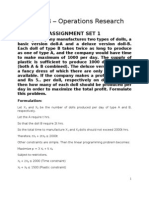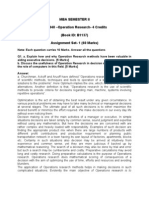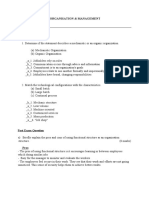Application_of_Integer_Programming_in_Project_Inve
Uploaded by
appolinaire.tougma09Application_of_Integer_Programming_in_Project_Inve
Uploaded by
appolinaire.tougma09WSEAS TRANSACTIONS on COMPUTER RESEARCH
DOI: 10.37394/232018.2020.8.14 Chunxue Zhao
Application of integer programming in project investment
CHUNXUE ZHAO
Anyang Normal University
School of Mathematics and Statistics
Xiange Street 436, Anyang
P.R.CHINA
Abstract: - Integer programming is widely used to solve optimization problems in economy, management,
communication and engineering.In this paper, we use the integer programming to solve the project investment
problem, which provides a solution to this type of problem.
Key-Words: - assignment problem, project investment, mathematical model
Received: May 11, 2020. Revised: July 3, 2020. Accepted: July 9, 2020. Published: July 13, 2020.
1 Introduction scheduling problems.Nakano[10] studied the
conventional genetic algorithm for job shop
Project investment is a kind of long-term investment problems. Li et.al.[11] gave uniform approach to
behavior which takes a specific project as the object model-based fuzzy control system design and
and is directly related to the new project or the structural optimization. In this paper, we first review
renovation project. How to allocate the limited the concepts of integer programming and the branch
resources to the unlimited investment of market and bound method of integer programming, and
demand, meet the requirements of project then we use the branch and bound method to solve
investment allocation and obtain the maximum the maximum profit problem.
economic benefits is a problem that every enterprise
In this paper, we first review the concepts of
investment decision maker must solve. There are Linear programming and integer programming. and
many methods of investment decision making, and then we use the integer programming to solve the
the linear programming theory and mathematical choice program of project investment.
model are effective tools to deal with some kinds of
investment decision making problems. In addition, 2 The Linear Programming and
Many practical problems can be transformed into Integer Programming
assignment problems, for example, Xiao et.al.[1]
studied the application of assignment problems in Linear programming is a branch of mature in
the supplier selection in supply chain. Liu et.al.[2] operational research. The maximum or minimum
discussed the generalized assignment problem and issues in linear objective function under the linear
its generalization application within the armaments condition are collectively referred to as linear
transportation. Liu[3] analyzed the multiple attribute programming problem. Solutions for the feasible are
group decision making based on the optimal linear solutions of linear constraints, the set made up of all
assignment. Goldberg et.al.[4] researched the messy the feasible solution is called the feasible region.
genetic algorithms. Cantu-Paz[5] gave a summary The decision variables, objective function and
of research on parallel genetic algorithms. constraint conditions are the three elements of linear
Eshelman[6] provided the CHC adaptive search programming problem.
algorithm. Srinivas[7] had a research on the
In linear programming problem, the optimal
adaptive probabilities of crossover and mutations in solution could be a fraction or a decimal, but for
GAs. Houck et.al.[8] gave a genetic algorithm for some specific problems,it can only take the integer
function optimization. Tsujimura et.al.[9] provided variables, such as the number of a factory, the
the genetic algorithms for solving multi-processor numbers of the running machine. Therefore, we call
E-ISSN: 2415-1521 111 Volume 8, 2020
WSEAS TRANSACTIONS on COMPUTER RESEARCH
DOI: 10.37394/232018.2020.8.14 Chunxue Zhao
the integer programming for planning problem max p 0.5 x1 0.4 x2 0.6 x3 0.5 x4 0.9 x5 x6
requiring the part or all of the decision variables to
be integer values.The basic expression of integer 5 x1 2 x2 6 x3 4 x4 6 x5 8 x6 22
programming is
xi 0, 1(i 1,2, ,6)
n
max(min) z c j x j Then the branch and bound method is used to
j 1 solve the model. Form table 1, we find that there is
n no obvious rule for the change between the data of
s.t
aij (, )b j (i 1,2, , m) investment amount and return, so the calculation can
j 1
be simplified by building a common standard, that is,
x j 0, x j is an int eger ( j 1,2, , n)
the return rate of each project can be obtained, and
the following solution can be obtained by unit
3 Modeling investment return. Therefore, table 1 is changed to
A company has 2.2 billion yuan of capital available table 2.
for investment, and now there are six investment
projects to choose from. The amount of investment
required for each project and the estimated annual Table 2: the return rate(unit: one hundred million
income are shown in table 1. yuan).
Table 1: Investment amount and income of each
project(unit: one hundred million yuan). project 1 2 3 4 5 6
project 1 2 3 4 5 6 Investment 5 2 6 4 6 8
Investment 5 2 6 4 6 8 Income 0.5 0.4 0.6 0.5 0.9 1
Income 0.5 0.4 0.6 0.5 0.9 1 Return rate 0.1 0.2 0.1 0.12 0.15 0.12
5 5
An investment plan is chosen to maximize The problem is simplified according to the return
returns.This problem involves the selection of rate of table2. Form table 2, the investment rate of
project investment and investment issues, each the second, fourth, fifth, sixth investment projects is
high and they are invested first. Because the return
project has two possibilities, which obtain a 0-1
rate of the first project is as low as he third project,
integer programming model, investment can be so we need to make a choice in the two projects.
expressed as 1, not investment be 0, then we use the Then the original problem is transformed into the
basic expression for solving integer relaxation problem, two groups optimal solution can
programming.There is 2.2 billion to invest in the be obtained as follows, respectively.
company, the investment amount of each project is 1
different, so we put the connection between the 0,1, ,1,1,1 x1, x2 , x3, x4 , x5 , x6
3
investment amount and the constrained variable as
2
the constraints to the problem, the maximum return ,1, 0,1,1,1 x1, x2 , x3 , x4 , x5 , x6
5
on investment as objective function to establish the
The revenue amount corresponding to these two
model.
solutions is 300 million yuan, it is obvious that they
are not feasible solutions to the original problem.
The total amount of investment I satisfies Therefore, to branch them, branch the first solution,
I 5 x1 2 x2 6 x3 4 x4 6 x5 8 x6 , Expected namely, branch the decision variable x3 into 0 and 1,
annual total return on investment p when x3 0 , the get optimal solution
satisfies 2
is ( ,1,0,1,1,1) . The solution is not a feasible
p 0.5 x1 0.4 x2 0.6 x3 0.5 x4 0.9 x5 x6 , the 5
mathematical model is following. solution to the original problem, so the branch
E-ISSN: 2415-1521 112 Volume 8, 2020
WSEAS TRANSACTIONS on COMPUTER RESEARCH
DOI: 10.37394/232018.2020.8.14 Chunxue Zhao
continues in the next step. when x3 1 ,the get
optimal solution is (0,1,1,0,1,1) , the solution is a
feasible solution to the original problem, so the
solution is retained. At this time, the profit is 290
million yuan. Then 0 p * 2.9 ( p * is the
maximum return on investment). we continue to
2
deal with the solution ( ,1,0,1,1,1) , in the previous
5
step, that is, branch the decision variable x1 , and
leave the decision variable x3 unchanged, we divide
it into these two cases: x1 0 and x1 1 .
When x1 0, x3 0 , the other variables remain
unchanged, the revenue of the solution is 280 Fig.1 The branching process
million yuan. When x1 1, x3 0 , we get two sets
1 5 To sum up, it can be concluded that the
of optimal solutions (1,1,0, ,1,1) and (1,1,0,1, ,1) , investment in the second, third, fifth and sixth
4 8
the corresponding annual income is 292.5 million projects yields the most, benefiting 290 million yuan.
yuan. At this time, only the two sets of solutions
with corresponding annual income of 292.5 million Integer programming can also be used for a
yuan are considered. They are not feasible solutions variety of assignment problem, often encountered
to the original problem and 0 p * 2.925 , So such a problem in practical life, there are x tasks
keep branching. need to be completed by y individual, each task has
1 a different character, each person also has the
Then we branch x4 in (1,1,0, ,1,1) , it is branch
4 characteristics of different, so different people have
into two cases: x4 0 and x4 1 , different efficiency to complete various tasks, this is
when x1 0, x3 0, x4 0 , the optimal solution about to use integer programming for personnel
assigned. In combinatorial optimization problem,
is (1,1,0,0,1,1) , the revenue was 280 million yuan,
the method of using 0-1 integer programming to
when x1 1, x3 0, x4 1 , the optimal solution
find the optimal solution in the set of feasible
5 solution. Also in the economic management
is (1,1,0,1,1, ) , the revenue was 292.5 million yuan,
8 problems, can use the integer programming model
continue to branch it. to solve the problem of investment, such as cutting
We branch x6 into two cases: x6 0 and x6 1 , problem.
when x1 1, x3 0, x4 1, x6 0 , the optimal
4 Conclusion
solution is (1,1,0,1,1,0) , At this point, the revenue is In this paper, we use the integer programming
230 million yuan, when x1 1, x3 0, x4 1, x6 1 , model and the branch and bound method to study
1 the project investment problem, which provides the
the optimal solution is (1,1,0,1, ,1) , At this time, theoretical support for the solution of such problems.
2
the revenue is 275 million yuan, greater than 230 Acknowledgements: The research was supported
million yuan, but the solution is not a feasible by National Natural Science Foundation of
solution to the original problem. In conclusion,
China(11801012) and National Social Science
2.75 p * 2.925 , so 290 million yuan is the Foundation of China(18CTJ007).
optimal value of the original problem, At this time,
the optimal solution is (0,1,1,0,1,1) . The branching
References:
process is represented by a tree diagram in figure 1.
[1] Xiao Zhi, Zhong Bo, Li Yingbing, The
application of assignment problems in the
E-ISSN: 2415-1521 113 Volume 8, 2020
WSEAS TRANSACTIONS on COMPUTER RESEARCH
DOI: 10.37394/232018.2020.8.14 Chunxue Zhao
supplier selection in supply chain, Operations Creative Commons Attribution License 4.0
Research and Management Science, 11, 3, (Attribution 4.0 International, CC BY 4.0)
2002, pp. 63-68.
[2] Liu Jiaxue, Chen Shiguo, Generalized This article is published under the terms of the Creative
assignment problem and its generalization Commons Attribution License 4.0
application within the armaments transportation, https://creativecommons.org/licenses/by/4.0/deed.en_US
Mathematics in Practice and Theory, 36, 1,
2006, pp. 199-203.
[3] Liu Jiaxue, The multiple attribute group
decision making based on the optimal linear
assignment, Systems Engineering, 19, 4, 2001,
pp. 32-36.
[4] Goldberg D E, Korb B, Deb K, Messy genetic
algorithms: motivation, analysis and first
results, Complex Systems, 3, 1989, pp. 493-530.
[5] Cantu-Paz E A, A summary of research on
parallel genetic algorithms, IlliGAL Report No.
95007, 1995.
[6] Eshelman L J, The CHC adaptive search
algorithm: How to have safe search when
engaging in noon-traditional genetic
recombination, In: Foundations of Genetic
Algorithms , Morgan Kaufmann Publishers,
1991, pp. 265-283.
[7] Srinivas M, Patnaik L M, Adaptive
probabilities of crossover and mutations in GAs,
In: IEEE Trans. on SMC, 24, 4, 1994, pp. 656-
667.
[8] Houck C R, Joines J A, A genetic algorithm for
function optimization: A MATLAB
implementation, NC-SU-IE TR95-09, 1995.
[9] Tsujimura Y, Gen M, Genetic algorithms for
solving multi-processor scheduling problems,
In: Simulated Evolution and Learning, First
Asia-Pacific Conference, SEAL’96, Taejon,
Korea, Springer, 1996, pp. 106-115.
[10] Nakano R, Conventional genetic algorithm for
job shop problems, In: Proceeding of the
Fourth International Conference on Genetic
Algorithms, 1991, pp. 474-479.
[11] Li Y, Ng K C, Uniform approach to model-
based fuzzy control system design and
structural optimization, In: Genetic Algorithms
and Soft Computing, Herrera F and Verdegay
J(ed), Physica Verlag, 1996, pp. 251-278.
E-ISSN: 2415-1521 114 Volume 8, 2020
You might also like
- A005A120020-Basic Equipment (L0L) From April 2010No ratings yetA005A120020-Basic Equipment (L0L) From April 20101,105 pages
- Assignment Guidelines - Project Scope and Time ManagmentNo ratings yetAssignment Guidelines - Project Scope and Time Managment8 pages
- Basic Numerical Method Using Scilab-ID2069No ratings yetBasic Numerical Method Using Scilab-ID20698 pages
- Multiobjective Optimization-Aided Decision-Making System for Large-Scale Manufacturing PlanningNo ratings yetMultiobjective Optimization-Aided Decision-Making System for Large-Scale Manufacturing Planning14 pages
- Mock Final Exam Project Management 3.3.2023No ratings yetMock Final Exam Project Management 3.3.20236 pages
- Mock Final Exam Project Management 3.3.2023No ratings yetMock Final Exam Project Management 3.3.20236 pages
- MB0048 - Operations Research: Assignment Set 1100% (1)MB0048 - Operations Research: Assignment Set 124 pages
- Selection of Job Shop Scheduling Problem Using Fuzzy Linguistic VariablesNo ratings yetSelection of Job Shop Scheduling Problem Using Fuzzy Linguistic Variables5 pages
- Chapter 8 Using Excel Solver Solve Mathematical Model Modul DssNo ratings yetChapter 8 Using Excel Solver Solve Mathematical Model Modul Dss45 pages
- The Decision Analysis For Project Investment Combining Exposure Preference and Benefit PursuingNo ratings yetThe Decision Analysis For Project Investment Combining Exposure Preference and Benefit Pursuing5 pages
- IM - BUMA 30083 - Fundamentals of Prescriptive Analytics (BSBA-MM TG 4-1) - Week 5No ratings yetIM - BUMA 30083 - Fundamentals of Prescriptive Analytics (BSBA-MM TG 4-1) - Week 59 pages
- Optimizing Time Cost Trade Off Scheduling by Genetic AlgorithmNo ratings yetOptimizing Time Cost Trade Off Scheduling by Genetic Algorithm9 pages
- 24 Design Engineering 24 Mohamed Soliman 1123No ratings yet24 Design Engineering 24 Mohamed Soliman 112316 pages
- A Fast Dynamic Assignment Algorithm For Solving ReNo ratings yetA Fast Dynamic Assignment Algorithm For Solving Re10 pages
- A Linear Programming Approach To Solving Stochastic Dynamic ProgramsNo ratings yetA Linear Programming Approach To Solving Stochastic Dynamic Programs39 pages
- The Economic Implications of Large Language Model Selection On Earnings and Return On Investment A Decision Theoretic ModelNo ratings yetThe Economic Implications of Large Language Model Selection On Earnings and Return On Investment A Decision Theoretic Model26 pages
- New Tools For Project Managers: Evolution of S-Curve and Earned Value FormalismNo ratings yetNew Tools For Project Managers: Evolution of S-Curve and Earned Value Formalism10 pages
- Indian Institute of Technology Bombay Department of Electrical EngineeringNo ratings yetIndian Institute of Technology Bombay Department of Electrical Engineering10 pages
- Analysis of Practical Applications Using The LineaNo ratings yetAnalysis of Practical Applications Using The Linea9 pages
- Technology Mca Master of Computer Applications Semester 1 2021 December Software Project Management Rev 2019 c SchemeNo ratings yetTechnology Mca Master of Computer Applications Semester 1 2021 December Software Project Management Rev 2019 c Scheme3 pages
- Mba Semester Ii MB0048 - Operation Research-4 Credits (Book ID: B1137) Assignment Set - 1 (60 Marks)No ratings yetMba Semester Ii MB0048 - Operation Research-4 Credits (Book ID: B1137) Assignment Set - 1 (60 Marks)20 pages
- Smu 4rt Sem Project Management AssignmentsNo ratings yetSmu 4rt Sem Project Management Assignments14 pages
- Homework # 8: Chapter 4, Exercise 3, Pp. 121-122No ratings yetHomework # 8: Chapter 4, Exercise 3, Pp. 121-1223 pages
- An Optimization Techniques On The Managerial Decision MakingNo ratings yetAn Optimization Techniques On The Managerial Decision Making10 pages
- Discrete Optimization: National Engineering School of TunisNo ratings yetDiscrete Optimization: National Engineering School of Tunis51 pages
- Fuzzy Optimization With Robust Logistic Membership Function: A Case Study in For Home Textile IndustryNo ratings yetFuzzy Optimization With Robust Logistic Membership Function: A Case Study in For Home Textile Industry5 pages
- Architecting Big Data & Analytics Solutions - Integrated with IoT & CloudFrom EverandArchitecting Big Data & Analytics Solutions - Integrated with IoT & Cloud4.5/5 (2)
- Computational Geometry: Exploring Geometric Insights for Computer VisionFrom EverandComputational Geometry: Exploring Geometric Insights for Computer VisionNo ratings yet
- 【NEW】ECG-A Series for EBS-G・EBR-G Series Specifications・How to order・Dimensions (3MB)No ratings yet【NEW】ECG-A Series for EBS-G・EBR-G Series Specifications・How to order・Dimensions (3MB)13 pages
- Grit Tank WALL 6M LengthX3.5M Height DesignNo ratings yetGrit Tank WALL 6M LengthX3.5M Height Design10 pages
- Environmental Summary - All Products-AlfombraNo ratings yetEnvironmental Summary - All Products-Alfombra5 pages
- Examinerreport Unit1 (WDM11) October2020No ratings yetExaminerreport Unit1 (WDM11) October20209 pages
- Functional Requirements of GIS: Data Capture Database Management Spatial Analysis Result PresentationNo ratings yetFunctional Requirements of GIS: Data Capture Database Management Spatial Analysis Result Presentation5 pages
- Structured Study Hall Policies Procedures 20-21No ratings yetStructured Study Hall Policies Procedures 20-211 page
- Assignment Guidelines - Project Scope and Time ManagmentAssignment Guidelines - Project Scope and Time Managment
- Multiobjective Optimization-Aided Decision-Making System for Large-Scale Manufacturing PlanningMultiobjective Optimization-Aided Decision-Making System for Large-Scale Manufacturing Planning
- Selection of Job Shop Scheduling Problem Using Fuzzy Linguistic VariablesSelection of Job Shop Scheduling Problem Using Fuzzy Linguistic Variables
- Chapter 8 Using Excel Solver Solve Mathematical Model Modul DssChapter 8 Using Excel Solver Solve Mathematical Model Modul Dss
- The Decision Analysis For Project Investment Combining Exposure Preference and Benefit PursuingThe Decision Analysis For Project Investment Combining Exposure Preference and Benefit Pursuing
- IM - BUMA 30083 - Fundamentals of Prescriptive Analytics (BSBA-MM TG 4-1) - Week 5IM - BUMA 30083 - Fundamentals of Prescriptive Analytics (BSBA-MM TG 4-1) - Week 5
- Optimizing Time Cost Trade Off Scheduling by Genetic AlgorithmOptimizing Time Cost Trade Off Scheduling by Genetic Algorithm
- A Fast Dynamic Assignment Algorithm For Solving ReA Fast Dynamic Assignment Algorithm For Solving Re
- A Linear Programming Approach To Solving Stochastic Dynamic ProgramsA Linear Programming Approach To Solving Stochastic Dynamic Programs
- The Economic Implications of Large Language Model Selection On Earnings and Return On Investment A Decision Theoretic ModelThe Economic Implications of Large Language Model Selection On Earnings and Return On Investment A Decision Theoretic Model
- New Tools For Project Managers: Evolution of S-Curve and Earned Value FormalismNew Tools For Project Managers: Evolution of S-Curve and Earned Value Formalism
- Indian Institute of Technology Bombay Department of Electrical EngineeringIndian Institute of Technology Bombay Department of Electrical Engineering
- Analysis of Practical Applications Using The LineaAnalysis of Practical Applications Using The Linea
- Technology Mca Master of Computer Applications Semester 1 2021 December Software Project Management Rev 2019 c SchemeTechnology Mca Master of Computer Applications Semester 1 2021 December Software Project Management Rev 2019 c Scheme
- Mba Semester Ii MB0048 - Operation Research-4 Credits (Book ID: B1137) Assignment Set - 1 (60 Marks)Mba Semester Ii MB0048 - Operation Research-4 Credits (Book ID: B1137) Assignment Set - 1 (60 Marks)
- An Optimization Techniques On The Managerial Decision MakingAn Optimization Techniques On The Managerial Decision Making
- Discrete Optimization: National Engineering School of TunisDiscrete Optimization: National Engineering School of Tunis
- Fuzzy Optimization With Robust Logistic Membership Function: A Case Study in For Home Textile IndustryFuzzy Optimization With Robust Logistic Membership Function: A Case Study in For Home Textile Industry
- Architecting Big Data & Analytics Solutions - Integrated with IoT & CloudFrom EverandArchitecting Big Data & Analytics Solutions - Integrated with IoT & Cloud
- Computational Geometry: Exploring Geometric Insights for Computer VisionFrom EverandComputational Geometry: Exploring Geometric Insights for Computer Vision
- 【NEW】ECG-A Series for EBS-G・EBR-G Series Specifications・How to order・Dimensions (3MB)【NEW】ECG-A Series for EBS-G・EBR-G Series Specifications・How to order・Dimensions (3MB)
- Functional Requirements of GIS: Data Capture Database Management Spatial Analysis Result PresentationFunctional Requirements of GIS: Data Capture Database Management Spatial Analysis Result Presentation





























































































